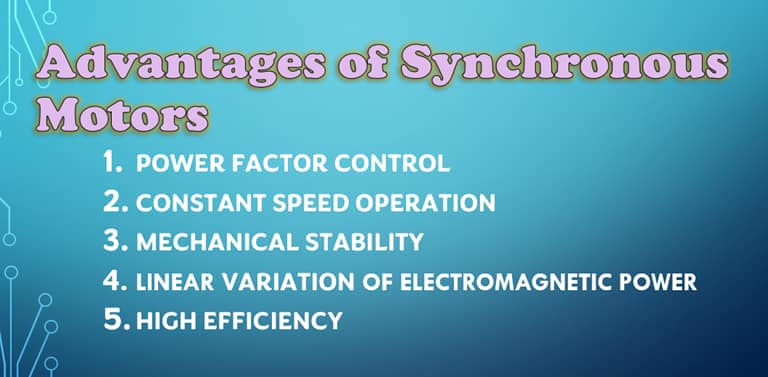Advantages and Disadvantages of Synchronous Motors
Synchronous motors play a crucial role in various industries, although their usage is relatively limited compared to induction motors. While induction motors are widely used because of their cheap prices, rugged construction, and low maintenance, synchronous motors offer unique advantages that make them valuable in certain applications. However, they also come with their own set of disadvantages. In this article, we will explore the advantages and disadvantages of synchronous motors in detail.

Advantages of Synchronous Motors
Power Factor Control: One of the advantages of a synchronous motor is ability to control the power factor. An overexcited synchronous motor works on the leading power factor, which can be run in parallel with induction motors and other inductive loads. By improving the system power factor, synchronous motors contribute to a more efficient and stable electrical network.
Constant Speed Operation: Unlike induction motors, synchronous motors maintain a constant speed regardless of the load they are driving. This characteristic is highly valuable in industrial applications where a consistent speed is required, irrespective of the load. It is particularly useful when the motor needs to drive another alternator to supply power at a different frequency, such as in frequency conversion systems.
Mechanical Stability: Synchronous motors can be constructed with larger air gaps compared to induction motors. This mechanical characteristic results in increased stability, enabling smooth operation even when subjected to substantial loads. Consequently, the risk of mechanical failures is minimized, ensuring dependable performance in challenging industrial settings.
Linear Variation of Electromagnetic Power: In synchronous motors, the electromagnetic power varies linearly with the voltage. This linear relationship simplifies the control and regulation of power output, making synchronous motors highly suitable for applications that require precise power control, such as in industrial processes that involve speed regulation or load balancing.
High Efficiency: Synchronous motors have higher efficiencies, especially in low-speed and unity power factor applications, compared to induction motors. With efficiency levels often exceeding 90%, synchronous motors offer energy savings and reduced operating costs, making them an economical choice for power-intensive industries.
Disadvantages of Synchronous Motors
DC Excitation Requirement: The disadvantage of synchronous motors is they require DC excitation, which must be supplied from external sources. This requirement adds complexity to the motor system, as it necessitates additional components and control mechanisms to provide the necessary excitation current.
Starting and Synchronizing Challenges: Compared to induction motors, synchronous motors are not self-starting and require external arrangements for starting and synchronizing. Starting a synchronous motor involves bringing it up to synchronous speed before connecting it to the power system. Specialized starting methods and synchronizing equipment are essential to ensure smooth and safe motor operation.
Higher Cost: The cost per kilowatt output of synchronous motors is generally higher compared to induction motors. The additional expenses associated with the DC excitation system, specialized starting equipment, and other necessary components contribute to the higher upfront cost of synchronous motors. However, it’s important to consider the long-term benefits and operating efficiencies when evaluating the overall cost-effectiveness of synchronous motors.
Limited Speed Control: Synchronous motors are unsuitable for variable speed applications unless the incoming supply frequency is adjustable. Unlike induction motors, synchronous motors lack inherent speed adjustment capabilities. Additional equipment such as Variable Frequency Drives (VFDs) must be employed to achieve variable speed control, which adds complexity and cost to the system.
Zero Starting Torque: Synchronous motors have zero starting torque, which means they cannot be started under load. This limitation requires careful consideration during motor selection and design. If a motor is required to start under load or provide high starting torque, an alternative motor type, such as an induction motor, maybe a more suitable choice.
Hunting Tendency: When the loading on a synchronous motor exceeds its capability, the synchronism between the rotor and stator rotating magnetic field is lost, causing the motor to come to a halt. This limitation necessitates careful monitoring and control of the motor’s operating conditions to prevent excessive loading that could lead to loss of synchronism.
Maintenance Requirements: Synchronous motors require collector rings and brushes, which increase the maintenance needs compared to induction motors. The brushes need to be regularly inspected, cleaned, and replaced.
Not suitable for Frequent Starting or High Starting Torques: Synchronous motors are not well-suited for applications that require frequent starting or high starting torques. The zero starting torque and the need for external starting arrangements limit their usability where frequent starts or high torque requirements are present.
Conclusion:
synchronous motors offer distinct advantages in terms of power factor control, constant speed operation, mechanical stability, linear electromagnetic power variation, and high efficiency. However, they also come with some disadvantages, including the need for DC excitation, starting and synchronizing challenges, higher cost, limited speed control, zero starting torque, hunting tendency, loss of synchronism, increased maintenance requirements, and not suitable for frequent starting or high torque applications. Understanding these advantages and disadvantages is crucial for making informed decisions regarding motor selection and their optimal usage in various industrial applications.